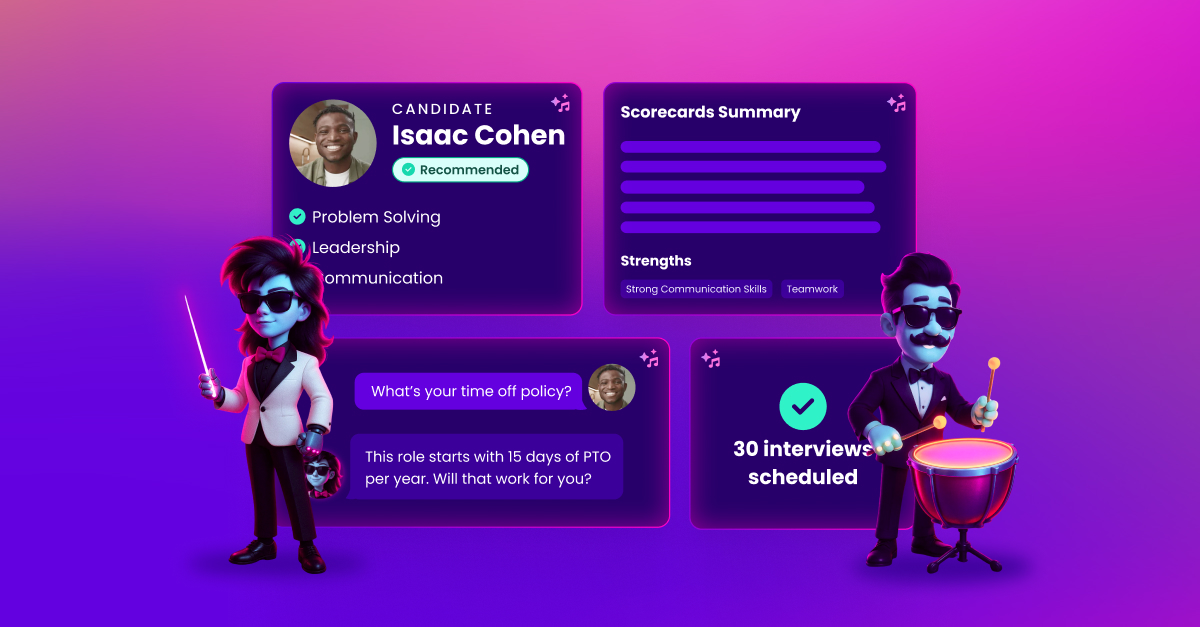Table of Contents
For many enterprise talent acquisition teams, AI, and in particular, agentic AI, presents a double-edged sword.
On one hand, it promises relief from never-ending admin work, complex scheduling puzzles, and the chaos that can come with hiring at a high volume across the globe. On the other, it raises a deeply rooted fear: If we automate too much, what are we giving up? Will we lose visibility into our hiring process? Will decisions get made without context? Will we wake up one day and realize we’ve handed over the wheel?
It’s a fair concern. Especially in high-stakes, high-volume recruiting environments, control and oversight aren’t just preferences — they’re necessities.
But here’s the truth: Full automation through AI doesn’t mean losing control. In fact, when it’s done right, automation gives you more of it.
More visibility into where things stand. More consistency across workflows. More time to focus on the parts of hiring that actually require human judgment — like relationship-building, interviewing, and strategic decisions. It’s not about letting go. It’s about getting out from under the chaos so you can lead from a place of clarity.
In this article, we’ll explore the common misconceptions about automation in hiring, show how the best teams are designing human-first workflows that increase transparency (not reduce it), and unpack what it really means to stay in control — even when most of the heavy lifting is handled for you.

Unlock 2026’s top hiring strategies: Insights from 500+ TA leaders
Be the first to uncover deep hiring insights specific to your sector — straight from the highest-performing TA teams.
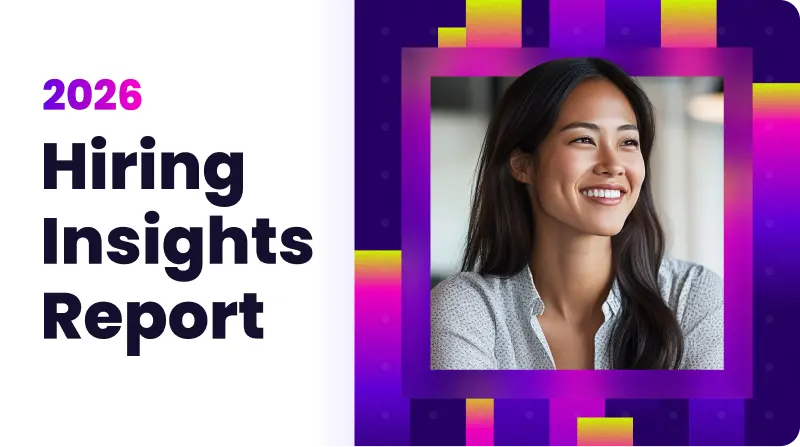
The misconceptions that stall progress and AI adoption
AI and automation in hiring sometimes get a bad rap — and not because TA leaders don’t value efficiency. Quite the opposite. Most talent teams are actively craving faster workflows, more consistency, and fewer hours lost to manual coordination.
What holds them back isn’t the idea of automation. It’s the misunderstanding of what automation really looks like in a modern, enterprise-grade talent environment.
Let’s unpack three of the most common misconceptions.
Misconception #1: Automation is a black box
Many teams worry that once automation is turned on, their visibility turns off. They imagine a system that runs in the background, making decisions without surfacing rationale or providing opportunities for intervention. And in some cases — especially with legacy systems or narrowly scoped tools — that concern is valid.
But the best automation doesn’t hide the work. It surfaces it.
Modern solutions designed for enterprise hiring log every action, provide real-time updates, and offer configurable checkpoints so teams can review, revise, or override at any point. Automation doesn’t take you out of the loop — it just clears out the clutter so you can actually see what’s happening.
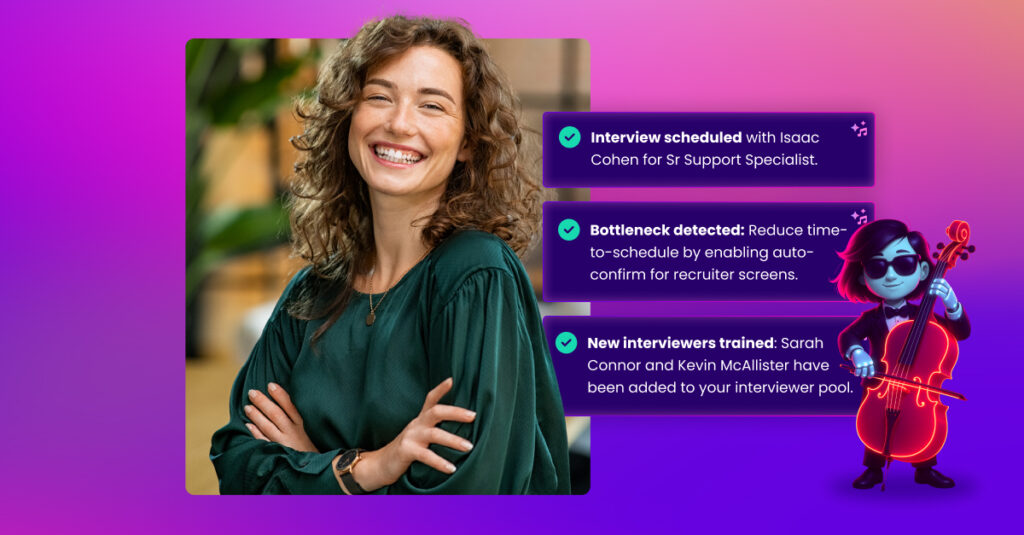
Misconception #2: Automation replaces human judgment
This is one of the most persistent myths. When we talk about automating interview scheduling, candidate screening, or feedback analysis, some hear “decisions will be made without us.”
In reality, automation isn’t about replacing your expertise — it’s about empowering it.
You set the strategy. You define what a “top candidate” looks like. You establish the guardrails. The automation then executes within that framework, freeing your team to focus on the nuanced, human decisions where your expertise matters most.
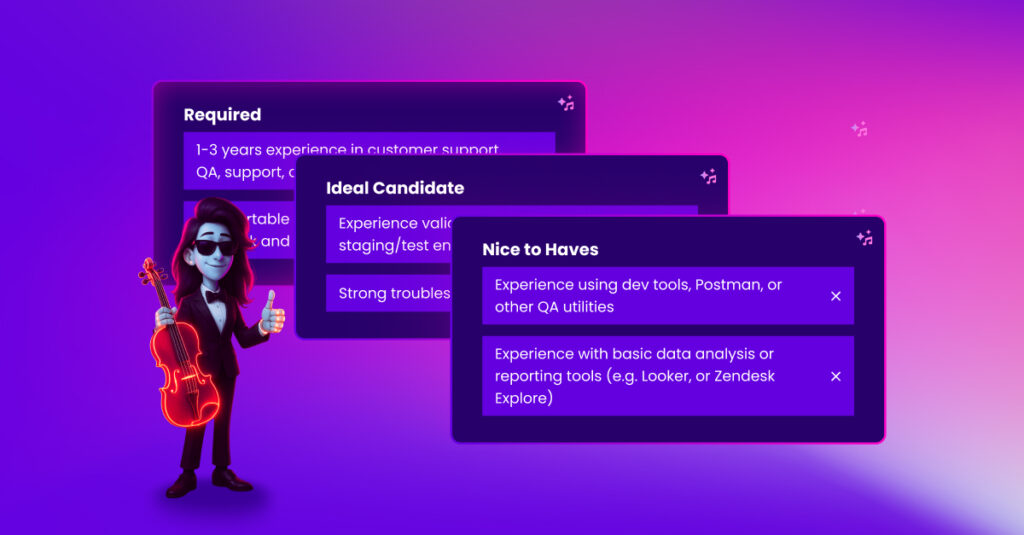
Misconception #3: Manual control equals better control
For many talent teams, control has historically meant touching every step: manually sending invites, manually reviewing resumes, manually checking calendar conflicts.
It feels safe. But it’s not scalable — and it’s not actually the best way to maintain oversight.
True control is about designing systems that reflect your hiring philosophy, then trusting those systems to execute with consistency, transparency, and accountability. The more manual your process, the more you’re relying on individual interpretation and memory. AI and automation don’t remove control — it codifies it.
In short: These fears are real, but they’re not rooted in today’s reality. Next, we’ll explore what automation actually looks like when it’s built for the needs of global, complex, and highly strategic talent acquisition teams.
Visibility, configurability, and oversight: What enterprise-grade AI agents actually deliver
The old image of automation in hiring — faceless systems making hidden decisions — doesn’t hold up anymore. Today, enterprise-ready AI isn’t about hiding actions. It’s about making them more visible, more configurable, and more aligned with how top talent teams work.
That’s especially true when we talk about AI agents in talent acquisition: autonomous systems designed to take specific actions across the hiring process — scheduling interviews, screening candidates, surfacing bottlenecks — all while keeping your team in control.
Here’s how modern AI agents like GoodTime’s Orchestra are changing the game.
1. Visibility: Every action is surfaced, not hidden
With traditional automation, teams often worry about what’s happening behind the scenes. But AI agents designed for enterprise workflows don’t operate in the dark — they surface everything they do.
Want to know which candidates were prioritized and why? See it. Curious who got scheduled and when? It’s there. Need to review the exact message a candidate received? Logged and visible.
In platforms like GoodTime’s Orchestra, every action an AI agent takes — from replacing a canceled interviewer to rescheduling a panel — is immediately accessible to your team. There’s no guessing. Just clarity.
2. Configurability: You set the rules, and the agents execute
Enterprise hiring is never one-size-fits-all. A scheduling approach that works for engineering roles in San Francisco won’t necessarily work for customer success hires in EMEA. That’s why leading AI platforms let you customize how agents behave — by job type, hiring stage, or team preferences.
You can configure:
- When agents take full action vs. when they flag for human review
- What criteria define a top candidate match
- How communications are personalized for candidates
- Guardrails around things like reschedules, auto-confirmation, or interviewer selection
Think of AI agents not as decision-makers, but as skilled executors of your strategy — able to handle volume and complexity, but always within your framework.
3. Oversight: Proactive intelligence that supports better decisions
The best part about AI agents isn’t just what they automate — it’s what they notice. Agents don’t just wait for instructions. They monitor your hiring flow, detect issues, and surface insights in real time.
If candidate drop-off is spiking after the second interview, your agents will flag it. If interview load is uneven across teams, they’ll recommend redistributing. If an offer is delayed due to feedback gaps, they’ll escalate it before it becomes a bottleneck.
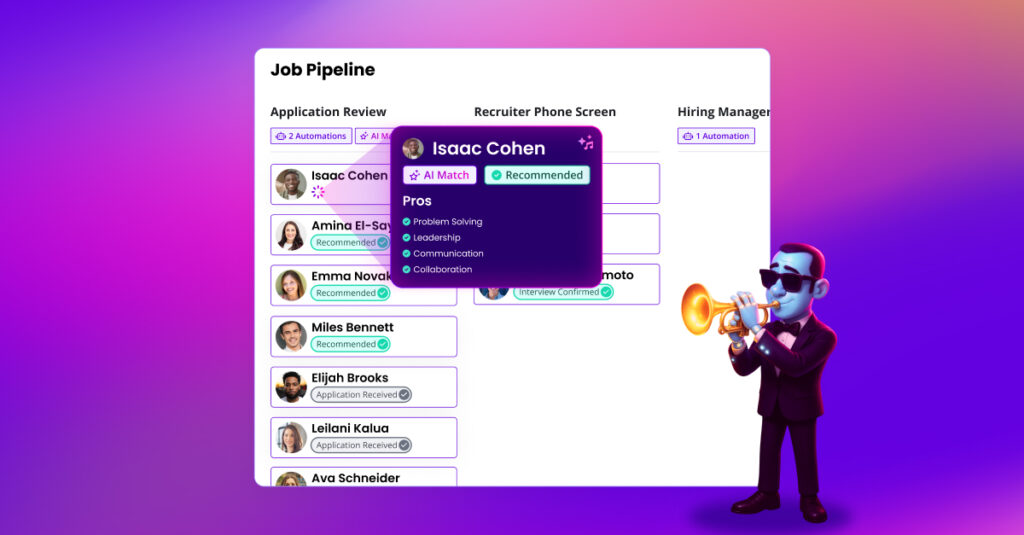
And none of this happens in a vacuum. You see the data, the recommendation, and the rationale — and you decide what to do. Oversight isn’t sacrificed — it’s elevated.
When AI agents are designed to support, not replace, human decision-makers, you don’t lose control. You codify it. You go from manually enforcing best practices to embedding them into your systems — with the added bonus of speed, consistency, and insight.
“What stood out to me about GoodTime was how much their AI philosophy aligns with ours. They are intentional about using AI and automation to eliminate repetitive, mundane tasks. That way, our recruiters, coordinators, and interviewers can spend time building relationships with candidates and connecting with them when and where it matters most.”
-Becky McCullough, VP of Talent Acquisition and Mobility, HubSpot
AI agents in practice: Examples of modern hiring workflows
It’s one thing to talk about control and clarity in theory. But what does it actually look like when AI agents are embedded into your hiring workflows?
Here are a few real-world examples of how AI-led automation and human oversight can work together — seamlessly.
Interview scheduling — faster, smarter, always visible
AI agents can handle interview coordination across time zones, teams, and panel formats — no spreadsheets, no endless back-and-forth. Agents find the right time, assign interviewers based on skills and availability, and send invites automatically.
But recruiters aren’t left out of the loop. They see:
- Who was scheduled, when, and with whom
- Why certain times or interviewers were selected
- Options to intervene, approve, or reschedule with a single click
Whether it’s one phone screen or a multi-day panel, your team maintains visibility and control — while letting agents do the coordination legwork.
Candidate screening — intelligent prioritization with built-in transparency
When AI agents screen candidates, they’re not just applying a mysterious score behind the scenes. They analyze resumes based on your defined criteria, match candidates to open roles, and surface the rationale for their decisions.
Recruiters can review:
- Which job requirements the candidate met
- How they compare to other applicants
- The logic behind automated ranking or advancement
Rather than spending hours triaging resumes, your team gets a head start — with insights they can trust, adjust, or override.
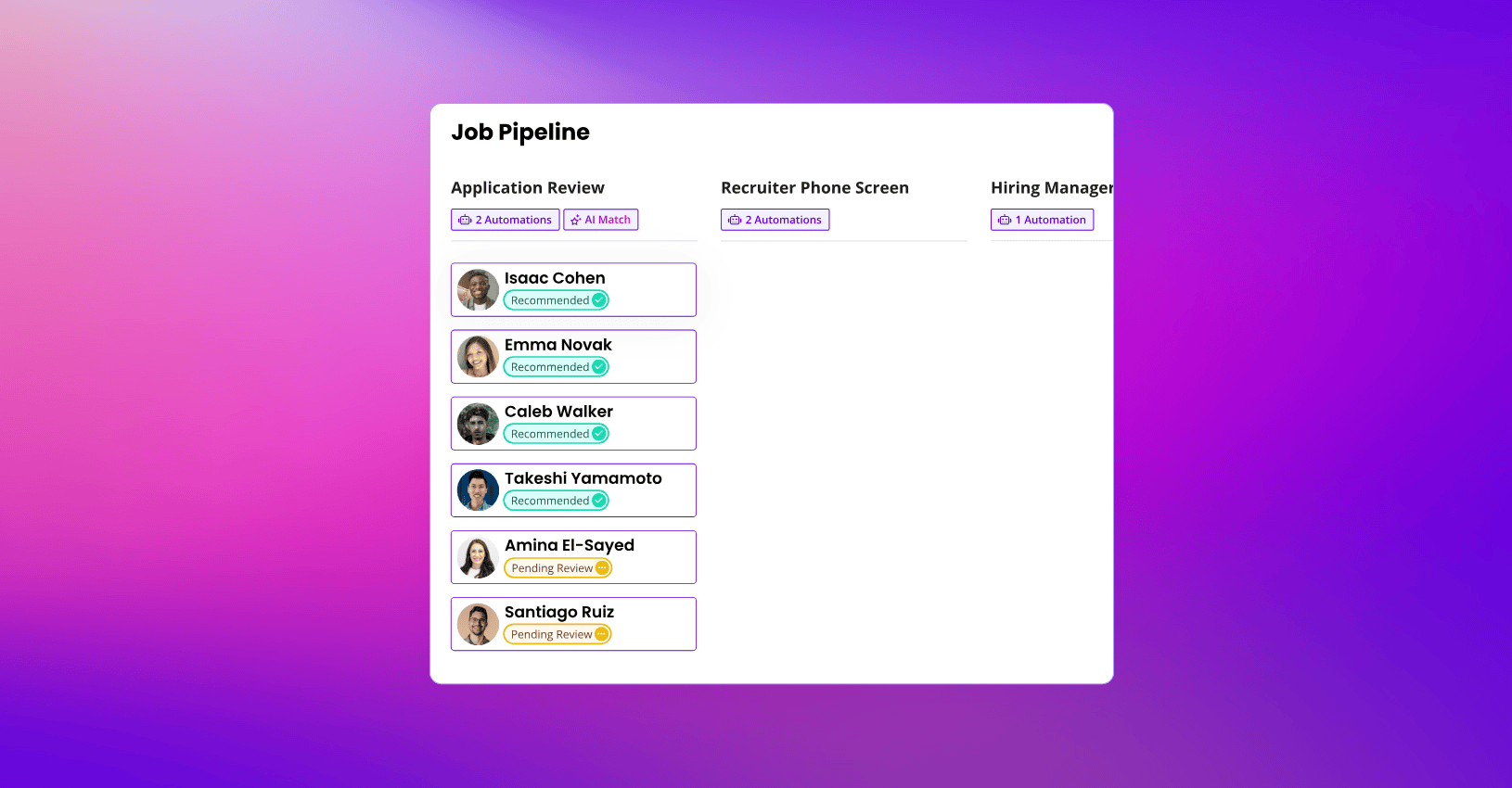
Bottleneck detection — insights before issues escalate
Instead of waiting until your hiring stalls out, AI agents continuously monitor pipeline health. They detect patterns that humans might miss, like:
- A specific interviewer consistently causing scheduling delays
- A stage where candidate drop-off increases
- Scorecards that are missing or conflicting
But they don’t just diagnose — they suggest. Agents might recommend adding interviewer coverage, nudging candidates, or adjusting timelines. Every suggestion is actionable and backed by data, and your team decides how to respond.
Candidate communication — always-on, never opaque
AI agents can engage candidates through email, SMS, WhatsApp, and portals — answering questions, sending reminders, and coordinating logistics 24/7. But crucially, they log every interaction.
Recruiters can see:
- What the candidate was told
- When it was sent
- Whether it was opened or replied to
Even better? If a candidate asks a sensitive question — like salary expectations or visa sponsorship — the agent flags it for a human to handle directly. Smart escalation ensures automation never replaces personal connection where it matters.
Together, these examples demonstrate a powerful truth: AI agents don’t have to operate independently to be effective. When built for visibility and collaboration, they actually enhance your ability to lead — by giving you clearer context, faster feedback, and real-time levers to pull.
Introducing Orchestra: A digital workforce designed for clarity and control
At GoodTime, we’ve taken this philosophy to heart. That’s why we built Orchestra — our coordinated system of AI agents designed to support talent teams across every stage of the hiring journey.
Orchestra isn’t a chatbot. It’s not a bolt-on. It’s an always-on digital workforce that:
- Screens and matches candidates to roles based on your specs
- Auto-schedules interviews, even across complex panels and time zones
- Flags bottlenecks before they impact hiring velocity
- Keeps candidates warm, informed, and engaged throughout
- Summarizes scorecards and provides insights to support faster decisions
But what makes Orchestra different is how it does these things: every action an agent takes is logged, explainable, and adjustable. Recruiters stay in the loop at all times — and can step in or modify any workflow as needed.
It’s full automation, with full transparency.
It’s AI that acts, not just chats.
And above all, it’s designed to keep hiring fast, human, and in sync — not by replacing your team, but by backing them up every step of the way.
“Prior to GoodTime, we were sitting at approximately 60 days to fill a position on the salary side. Since implementing GoodTime, that number has dropped to about 45 days time to fill.”
-Joe Albano, Director of Talent Acquisition, HelloFresh
The real benefit: More time for what matters
At the heart of every high-performing talent team is a simple truth: what drives hiring success isn’t the mechanics — it’s the moments.
It’s the honest conversations that build alignment with a hiring manager. The thoughtful outreach that turns a passive candidate into a must-have hire. The calibration, collaboration, and context-sharing that elevates not just who you hire, but how you hire.
But those moments only happen when your team isn’t buried in busywork.
That’s where AI agents shine. By automating the repeatable tasks — scheduling, screening, reminders, follow-ups — they give recruiters back their most precious resource: time.
Time to:
- Build stronger hiring manager partnerships
- Personalize candidate experiences
Strategize across business units and geographies - Improve processes instead of just managing them
And because every action taken by an AI agent is visible and adjustable, your team doesn’t lose control — they gain it. They get to lead the hiring journey, not get lost in it.
With AI agents like those in GoodTime’s Orchestra, teams are transforming chaos into clarity — not by letting go, but by stepping up. They’re reclaiming time, sharpening their focus, and leading hiring with confidence, precision, and humanity.
Because when automation is human-first, control isn’t lost, it’s multiplied.
